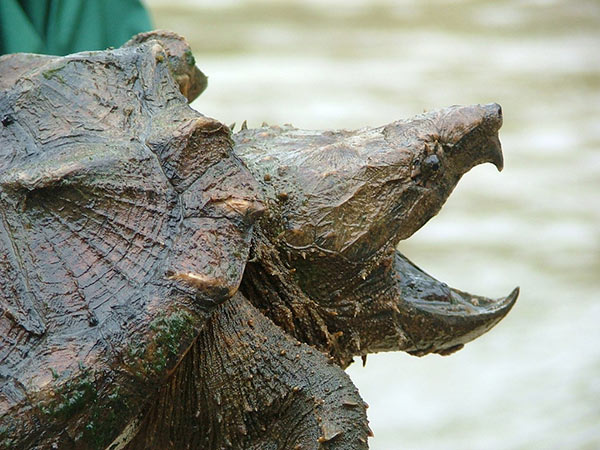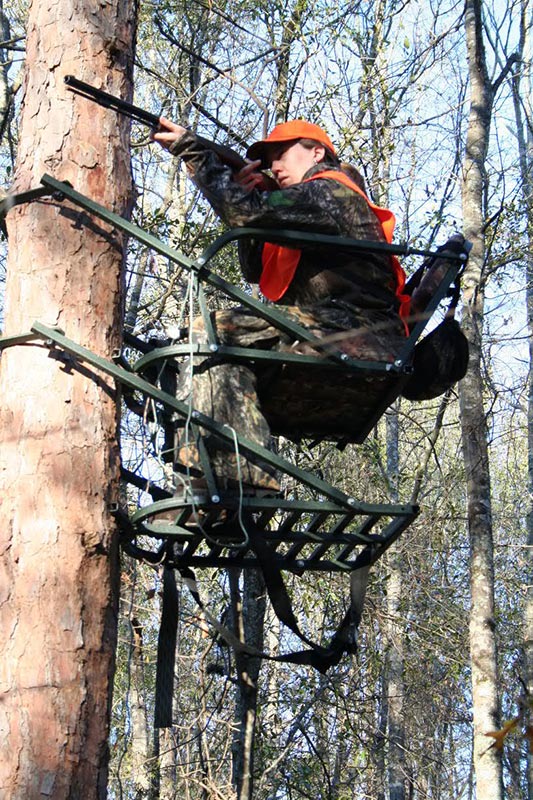

More than two decades after Georgia protected alligator snapping turtles from commercial trapping, these heavyweight turtles with lightning-quick jaws are struggling to rebound in a former river stronghold.
Researchers who caught and released alligator snappers on the Flint River last year recorded a catch rate only slightly higher than a similar study in 1989, according to a recent report. Survey leaders expected numbers that pointed to a stronger population.
“Nearly 25 years after the harvest was shut down, they’re still slow to recover,” said Dr. Lora Smith of the Joseph W. Jones Ecological Research Center in Newton.
The alligator snapper is North America’s biggest and maybe even baddest freshwater turtle. Males can weigh more than 200 pounds and sport 30-inch-long shells lined with jagged ridges. Their jaws can snap with pressures exceeding 1,000 pounds. In Georgia, these turtles are found in stream and river systems, primarily in the Coastal Plain, that drain into the Gulf of Mexico. The Flint anchors that range.
The state declared alligator snappers a threatened species in 1992. But demand for the big, easily trapped turtles as soup meat had already decimated populations in southwest Georgia’s Flint drainage. Thousands were harvested during the 1970s and early ’80s, the hey-day of commercial trapping. One trapper said he averaged catching 1,000 pounds a day.
The species’ slow growth, maturation and reproduction rates intensified the fallout, said senior wildlife biologist John Jensen of the Georgia Department of Natural Resources. “The reality of the life history of most turtles … indicates that recovery from heavy declines like this is going to take much longer.”
A petition to list alligator snapping turtles under the U.S. Endangered Species Act spurred last year’s survey, commissioned by the DNR Nongame Conservation Section and conducted by Rachel King, then working with the Jones Center. Using hoop nets baited with cut fish, King trapped turtles in the mainstem Flint from Lake Seminole near Bainbridge north to Salem in middle Georgia’s Upson County.
The 56 alligator snappers caught and released from May through September equaled 0.09 turtles per night per trap (the species feeds mostly at night). The catch rate in the 1989 survey was 0.08. The trapper who did the earlier survey for DNR estimated he averaged a turtle a night per trap in the 1970s.

turtle may obtain weights over 100 kg (220 lbs) and carapace lengths up to 80 cm (31½ inches). Common snappers are frequently seen on land while alligator snappers almost never leave the
water except to nest.
On a more hopeful note, the project trapped more juvenile turtles than 25 years ago, a promising sign of reproduction; yielded catch rates that may show a population increase in the Flint River south of Albany, one of the most heavily harvested reaches; and, marked an increase in average mass of turtles. One turtle weighed 90.4 pounds; 10 exceeded 60 pounds.
King, who now works with gopher tortoises for the Florida Fish and Wildlife Conservation Commission, said one possible factor that could be hampering the recovery in the Flint is illegal trapping and incidental harvest of alligator snappers by limb or trot lines and submerged traps. Some people she met on the river complained about the turtles being protected, saying they were common and good to eat.
“I feel there definitely needs to be a little more education about the ecology of this species,” King said.
The DNR Nongame Conservation Section works to conserve Georgia’s endangered and other wildlife not legally fished for or hunted, as well as rare plants and natural habitats. The agency does not receive state appropriations for conservation, depending instead on fundraisers, grants and contributions.
Public support is vital. Georgians can provide help conserve species such as alligator snapping turtles by:
Buying or renewing a DNR eagle or hummingbird license plate. Most money from sales and renewals is dedicated to nongame conservation. Upgrade to a “wild” tag for only $25!
Contributing to the Georgia Wildlife Conservation Fund when filing state income taxes – line 26 on Form 500 or line 10 on Form 500EZ. Giving is easy and every donation helps.
Making a direct donation. Details at www.georgiawildlife.com/conservation/support.
Learn more about nongame in Georgia: www.georgiawildlife.com/conservation/annualreport.
ON THE NET
- Alligator snapping turtle survey report: www.georgiawildlife.com/research
- DNR video on the survey start: www.youtube.com/GeorgiaWildlife (under “Nongame Wildlife and Conservation”)
- Rare wildlife species profiles: www.georgiawildlife.com/rare_species_profiles
- Support wildlife conservation: www.georgiawildlife.com/conservation/support







Be the first to comment